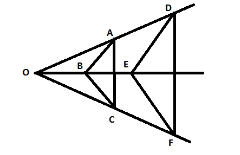
In the given figure $ AB\parallel DE $ and $ BC\parallel EF $ . Prove that $ AC\parallel DF $


Answer
549.9k+ views
Hint: In this question, it has been given that $ AB\parallel DE $ and $ BC\parallel EF $ . We need to prove that $ AC\parallel DF $ . We will prove this condition, by using basic proportionality theorem and converse of basic proportionality theorem. We are using BPT because here the triangles are similar.
Complete step-by-step answer:
It has been given that $ AB\parallel DE $
We know that, if a line is drawn parallel to one side of a triangle intersecting the other two sides on distinct points, then the other two sides are divided in the same ratio. This is called the basic proportionality theorem (BPT).
Therefore, by basic proportionality theorem, we have,
$ \dfrac{{OA}}{{OD}} = \dfrac{{OB}}{{OE}} $
Let it be equation 1
It is also given that $ BC\parallel EF $
Therefore, by basic proportionality theorem, we have,
$ \dfrac{{OC}}{{OF}} = \dfrac{{OB}}{{OE}} $
Let it be equation 2
Comparing the equations 1 and 2, we have,
$ \dfrac{{OC}}{{OF}} = \dfrac{{OA}}{{OD}} $
Now, we know that, if a line divides any two sides of a triangle in the same ratio, then the line is parallel to the third side. This is known as converse of basic proportionality theorem.
Therefore, by converse of basic proportionality theorem, we can say that,
$ AC\parallel DF $
Hence, proved that $ AC\parallel DF $ .
So, the correct answer is “$ AC\parallel DF $”.
Note: In this question, it is important to note here that if the two triangles are similar then we can use the basic proportionality theorem. When the two triangles are similar then, corresponding angles of both the triangles are equal and corresponding sides of both the triangles are proportional to each other. Basic proportionality theorem is also known as Thales theorem because BPT was introduced by a famous Greek Mathematician, Thales. The converse of any theorem is just a reverse of the original theorem, just like we have active and passive voices in English.
Complete step-by-step answer:
It has been given that $ AB\parallel DE $
We know that, if a line is drawn parallel to one side of a triangle intersecting the other two sides on distinct points, then the other two sides are divided in the same ratio. This is called the basic proportionality theorem (BPT).
Therefore, by basic proportionality theorem, we have,
$ \dfrac{{OA}}{{OD}} = \dfrac{{OB}}{{OE}} $
Let it be equation 1
It is also given that $ BC\parallel EF $
Therefore, by basic proportionality theorem, we have,
$ \dfrac{{OC}}{{OF}} = \dfrac{{OB}}{{OE}} $
Let it be equation 2
Comparing the equations 1 and 2, we have,
$ \dfrac{{OC}}{{OF}} = \dfrac{{OA}}{{OD}} $
Now, we know that, if a line divides any two sides of a triangle in the same ratio, then the line is parallel to the third side. This is known as converse of basic proportionality theorem.
Therefore, by converse of basic proportionality theorem, we can say that,
$ AC\parallel DF $
Hence, proved that $ AC\parallel DF $ .
So, the correct answer is “$ AC\parallel DF $”.
Note: In this question, it is important to note here that if the two triangles are similar then we can use the basic proportionality theorem. When the two triangles are similar then, corresponding angles of both the triangles are equal and corresponding sides of both the triangles are proportional to each other. Basic proportionality theorem is also known as Thales theorem because BPT was introduced by a famous Greek Mathematician, Thales. The converse of any theorem is just a reverse of the original theorem, just like we have active and passive voices in English.
Recently Updated Pages
Master Class 9 Social Science: Engaging Questions & Answers for Success

Master Class 9 Science: Engaging Questions & Answers for Success

Master Class 9 Maths: Engaging Questions & Answers for Success

Master Class 9 General Knowledge: Engaging Questions & Answers for Success

Class 9 Question and Answer - Your Ultimate Solutions Guide

Why is there a time difference of about 5 hours between class 10 social science CBSE

Trending doubts
Which places in India experience sunrise first and class 9 social science CBSE

Which is the largest Gulf in the world A Gulf of Aqaba class 9 social science CBSE

Fill the blanks with the suitable prepositions 1 The class 9 english CBSE

Write the 6 fundamental rights of India and explain in detail

Difference Between Plant Cell and Animal Cell

What is pollution? How many types of pollution? Define it




